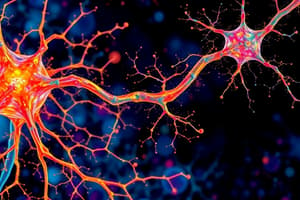Podcast
Questions and Answers
What is the primary effect of grade I injury on the axon?
What is the primary effect of grade I injury on the axon?
- Retrograde reaction in the nerve cell body
- Degeneration of the axon distal to the cut
- No significant effect on the axon (correct)
- Regeneration of the axon proximal to the cut
What is the typical timeframe for the complete degeneration of Nissl granules in the nerve cell body?
What is the typical timeframe for the complete degeneration of Nissl granules in the nerve cell body?
- Within 5-10 days of injury
- Within 30-40 days of injury
- Within 50-60 days of injury
- Within 15-20 days of injury (correct)
What is the consequence of the nucleus being extruded from the cell body?
What is the consequence of the nucleus being extruded from the cell body?
- No effect on the neurone
- Regeneration of the neurone
- Reformation of the myelin sheath
- Degeneration of the neurone (correct)
What is the role of macrophages in the process of degeneration?
What is the role of macrophages in the process of degeneration?
What is the typical timeframe for the repair of the nerve cell body to begin?
What is the typical timeframe for the repair of the nerve cell body to begin?
What is the consequence of the cell body regaining its normal size?
What is the consequence of the cell body regaining its normal size?
What type of degeneration occurs from the point of damage to the terminal endings?
What type of degeneration occurs from the point of damage to the terminal endings?
What is the purpose of macrophages from the endoneurium during the regeneration process?
What is the purpose of macrophages from the endoneurium during the regeneration process?
What guides the regeneration fibrils during the regeneration process?
What guides the regeneration fibrils during the regeneration process?
What is the maximum percentage of original diameter that a peripheral nerve can achieve after regeneration?
What is the maximum percentage of original diameter that a peripheral nerve can achieve after regeneration?
What type of cells form the myelin sheaths around several nerve cells in the CNS?
What type of cells form the myelin sheaths around several nerve cells in the CNS?
What occurs during Regenerative Sprouting?
What occurs during Regenerative Sprouting?
Flashcards are hidden until you start studying
Study Notes
Wallerian Degeneration
- The axon degenerates distal to the cut if the axon is severed, and the neuron's cell body maintains the functional and anatomic integrity of the axon.
- There are 5 different grades of injury, with Grade I being the least harmful and Grade V being the most harmful (complete severance of the nerve).
Retrograde Reaction
- Chromatolysis occurs within 24 hours of injury, causing Nissl granules to disappear.
- The Golgi apparatus then starts to disintegrate, and neurofibrils also disappear.
- The cell body imbibes water and swells, assuming a spherical shape.
- The nucleus is pushed to one side of the cell body.
Cell Body Changes
- If the nucleus is extruded, degeneration of the neuron occurs.
- If the nucleus is retained, regeneration of the neuron occurs.
- Repair begins ~20 days following injury and is usually complete in ~80 days following injury.
- Nissl granules and Golgi apparatus gradually reappear, and the cell regains its normal size.
Nerve Fibre Changes
- The myelin sheath breaks down, and macrophages are implicated in this process.
- Orthograde or Wallerian degeneration occurs from the point of damage to the terminal endings.
- Retrograde degeneration occurs to the nearest collateral or axon branch.
- Schwann cells divide mitotically, forming cords of cells lying within the endoneurial tubes.
Regeneration
- Macrophages from the endoneurium invade the degenerating myelin sheath and axis cylinder and remove debris.
- As debris is removed, Schwann cell cytoplasm fills the endoneurial tubes.
- The process takes ~3 months.
- Schwann cells elongate and send processes outward to the injured site (Regenerative Sprouting).
- Neurofibrils from the proximal end begin to grow and are guided by the Schwann cells into the old cylinder.
- Schwann cells then spin new myelin sheaths around the cylinder, and gradually the entire neuron is regenerated.
- The central axon elongates and then grows out in all directions.
- Regeneration fibrils appear to be guided by strands of Schwann cells of the peripheral endoneurial tubes.
- Schwann cells filling the endoneurial tubes form the medullary sheath around the successful fibril similarly to the developing nerve fibre.
- The peripheral nerve rarely achieves more than 80% of its original diameter.
- Regeneration does not normally occur in the CNS.
Studying That Suits You
Use AI to generate personalized quizzes and flashcards to suit your learning preferences.




